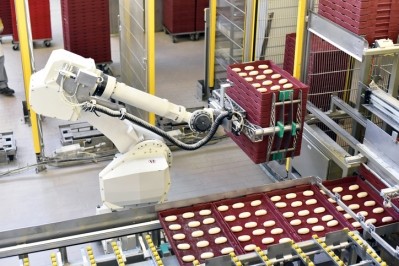Feature
Digitalisation: How to embrace digital transformation in the food and drink factory

While the general public may perceive the manufacturing sector as one dominated by low paid, inflexible jobs in filthy workspaces, the truth is that the industry is on the cusp of a digital transformation that promises to bring a lot of new opportunities.
But you needn’t be worried about the industry suddenly rushing into a bold new future at breakneck speed. As Dr Robert Stewart at the University of Strathclyde tells it: “the future’s bright, but hold back on the shades for now.”
As of right now, much digitalisation projects in food factories look to replace manual processes, such as heavy lifting or repetitive tasks that could be handled by a machine. While smart factories or dark factories do crop up from time to time, they certainly aren’t the norm or the direction most SMEs are heading towards.
At the heart of any decision to digitalise are the numerous challenges facing food and drink businesses. For an industry already running on tight margins and working round the clock to keep the nation fed, the permacrisis has forced manufacturers to re-evaluate their businesses and how they can adapt and improve.
As TNA Solutions group XR manager-projects Natasha Avelange puts it, the challenges highlight that the industry is in a transitional phase that is being accelerated by rising energy and raw material costs.
“Processes honed over many years based on full employment and robust supply chains will inevitably have to change, but where manufacturers are driven to achieve efficiencies there are benefits to be reaped if changes are addressed in the right way,” she continued.
“Transition – or change – presents opportunity, and the way to take advantage in a digital age is to leverage technological advances. In short, digitalisation is the way forward.”
Digitalisation for the right reason
Manufacturers need to be sure on their reasoning behind digitalising their factories. After all, the process can be a costly one, especially for SMEs.
Food Manufacture’s webinar on ‘Strategies for improving your supply chain traceability’ raised important questions around technology investments, as well as highlighting some current and emerging tools for enhanced traceability, including 2D barcodes.
“It's critical to have an understanding about what you're actually trying to do with the technology,” said Stewart. “You hear a lot of tales of companies who bring in a new piece of kit and they find out at that point that they haven't thought about it – that the new kit doesn't quite work in the way that they thought, or it doesn't adapt to X, Y or Z.”
One of the most common mistakes is attempting to save money by pursuing a one-size-fits-all approach to your digitalisation. Josephine Coombe, chief commercial officer at supply chain systems provider Nulogy, explained how business leaders have tried and failed stretched a system such as an Enterprise Resource Planning (ERP) or Manufacturing Execution System (MES) to cover more specialised requirements of the business, such as e-commerce fulfilment or contract packing operations.
“Successful digital transformation strategies, however, typically leverage a best-of-breed approach, i.e., finding the right, purpose-built solution for the particular job at hand,” said Coombe. “While that might appear more costly, as you are investing in more than one system, the longer-term return on investment will be greater, and the time-to-value will be shorter.
“And while ERP and manufacturing software consultants may tell you they can do it all, believing these promises far too often leads to costly and unexpected customisations, quality problems and persistent errors, and ultimately failed implementations.
“In contract packing for example, a dedicated contract packing software solution such as Nulogy's offers far more functionality specific to co-pack workflow than will be found in a WMS or generalist manufacturing execution or ERP system. That translates into faster, successful implementations that get your people productive and your lines optimised, quickly and more cost effectively.
Friendly advice
When all else fails, it doesn’t hurt to ask for advice from businesses that have successfully implemented their own digitalisation projects. This isn’t a journey that you have to take on your own and there are plenty of people out there who can teach you what they’ve learned.
“It’s about learning lessons from people who use the tech, trying to understand from people who sell and market the tech – ‘what are the upsides, what the downsides?’ – and then speaking to your workers and trying to take them along,” Stewart explained.
Josephine Coombe at Nulogy echoed Stewart’s advice: “If you’re unsure whether a best-of-breed solution is warranted, ask for proof points and reference customers. These should be live, successful implementations in environments comparable to your own. And be wary of promises to build what’s missing – do you really want to be someone’s guinea pig?
For business concerned with the costs involved in digitalising their factories, there are a few avenues you can explore in terms of grants to support your projects. Made Smarter is one of the premier schemes for businesses looking to adopt digital technologies into their businesses with a long track record of supporting food and drink manufacturers.
Jonathan Richards, head of marketing and external relations for Made Smarter, spent eight years working with food and drink firms across providers such as Hitachi and Mettler Toledo before joining the organisation. It’s from this experience that he has been able to identify some of the key areas in which organisations such as Made Smarter are able to aid manufacturers.
“I think a lot of the businesses that are interested in digital transformation are actually time poor,” said Richards. “They're making product and trying to sell product and worrying about how they're going to satisfy the next order that they can't necessarily give themselves the headspace to think about digital transformation.
“You end up in a situation where you're working to meet the current needs of your business, but you can't then get past that and you can't then expand because actually trying to grow your business becomes really difficult because you've forever fighting fires.”
In these situations, just having an organisation like Made Smarter come in to help figure out a plan of action for your business can be a life saver.
No choice?
Ultimately though, manufacturers may not have a choice. The future is now and those unwilling or unable to keep up will be left in the dust. As Stewart explained: “There probably is a place for more traditional factories. However, your competitors will be doing it [digitalisation]. Your customers might be expecting faster, quicker things – your competitors will be doing that.”
As Stewart mentioned, this isn’t an excuse to run headfirst into a digitalisation project. Jumping on the bandwagon is a surefire way to create problems if you don’t know what the tech will be used for and how it will fit into your business.
“But the future is tech and they will all do it at some point sooner or later,,” he added.
This doesn’t mean you need to start planning to replace workers on the line with robot arms or make it so every piece of equipment can be remotely controlled. A digitalisation project can be as simple as updating the communication system in the factory and the ability to talk with people using programmes such as Microsoft Teams – a system many of us are quite intimate with since the COVID-19 lockdowns.
“Whilst the prospect of adopting smart digital technologies can be overwhelming, especially in the face of an uncertain economic outlook, the simple truth is there are no areas of the food production process that don’t stand to benefit from digitalisation,” concluded Natasha Avelange at TNA Solutions.
“The key responsibility for OEMs is to cut through the complexity and to make digital technologies not only more attractive, but more accessible to food brands. Empowered with straight-forward advice from an expert processing and packaging partner, manufacturers have nothing to lose by going digital, and everything to gain.”
Simple steps for your digitalisation journey
Saujanya Suman, a senior consultant for the food and beverage industry at FutureBridge, laid out some simple steps that manufacturers should consider to successfully implement digitalisation.
Understand your process: Every food manufacturer has its own supply chain process, right from receiving to the end-product. As implementing any digital process will require installation of hardware and software devices throughout its operations, it is important to understand how information is collected and stored. Identifying the overall supply chain strength and weakness will determine which digital technologies are more relevant.
Define digital strategy: Setting clear goals for achieving the objectives of digital transformation is important before identifying which technologies to be adopted. Also, it is important to consider the challenges and opportunities associated with the technologies to mitigate the risks.
Explore the options: Identify the best-fit digital technology that fits your requirements based on parameters. These parameters can include cost and investment needs, technical challenges, technology compatibility with existing manufacturing processes, food safety and compliance requirements, and addressing sustainability aspects.
Implementing common standards: A common data standards must be adopted across the supply chain for process efficiency, such as GS1 Electronic Product Code Information Services (EPCIS), which is an open standard used by manufacturers for capturing and sharing information during the supply chain with different stakeholders.
Implementing agile processes: While implementing any technology for the first time, organisations face challenges in identifying the right metrics which can hinder the process. An agile methodology helps to significantly improve the quality of the process.
Training and development: Bring the culture of innovation and knowledge sharing across the organisation by encouraging employees to involve in experimenting with new digital technology and by providing training on the new skill to employees.
Monitoring: Continuously monitor the progress by analysing data such as operational productivity and efficiency, quality control, profitability, and customer satisfaction.


















